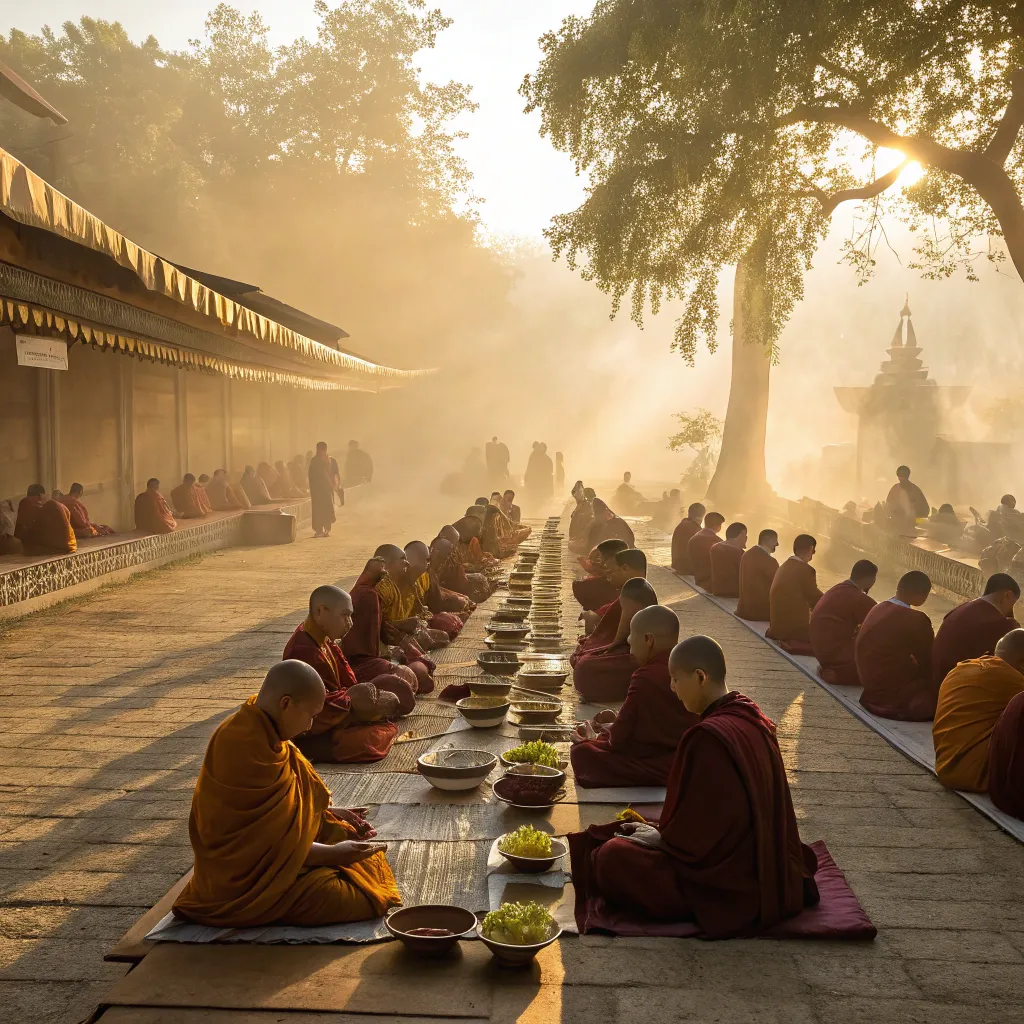
The Kathina Festival
A Celebration of Generosity and Spiritual Unity
Honoring Tradition: What Makes the Kathina Festival Unique?
Every autumn, as the rainy season ends across much of Southeast Asia, Buddhist communities come together to celebrate Kathina—a tradition that dates back over 2,500 years. More than just a ceremonial event, Kathina represents a deep-rooted expression of generosity, gratitude, and interconnectedness. Held between October and November, it is recognized as the largest alms-giving event in the Buddhist calendar.
In an age where connection often feels digital and distant, Kathina brings people together in a powerful, physical manifestation of unity—linking monks and laypeople in shared values and purpose.
The Origins of Kathina: A Story of Resilience and Compassion
A Rainy Season and a Spiritual Beginning
The Kathina ceremony is said to have been introduced by the Buddha himself, following a story of thirty monks who were unable to join him before the start of Vassa, the annual three-month rainy season retreat. Bound by muddy roads and heavy monsoons, the monks chose to remain in one location, practicing in harmony and discipline.
When they finally met the Buddha again, he honored their dedication by initiating the Kathina ceremony, encouraging laypeople to offer new robes as a gesture of support. This marked the beginning of a tradition that reflects not just material generosity, but also spiritual connection.
Kathina’s Deeper Meaning: Transition and Togetherness
The End of Retreat, the Start of Giving
Kathina takes place immediately after Vassa, a time when monks return from introspection and seclusion to rejoin the community. It is a symbolic transition from inward reflection to outward connection.
But the meaning goes beyond dates and rituals. Kathina reinforces the reciprocal relationship between the monastic and lay communities. Monks receive what they need to continue their path, while laypeople accumulate merit through acts of generosity—a core pillar of Buddhist practice.
A Modern Celebration: How Kathina Is Observed Today
Offering the Robe with Heart
At the heart of Kathina lies a beautifully simple act: offering cloth to monks so they may sew new robes. This offering, known as Kathina Civara Dana, can be made only once a year, during a strictly defined four-week window following the end of Vassa. What makes it unique is that it must be given spontaneously, without request from the monks—emphasizing the purity of intention behind the gift.
The chosen cloth is then transformed into a robe by the monastic community, often sewn overnight before dawn. This tradition is not just practical, but also meditative—bringing community members together in a shared task rooted in mindfulness and service.
Beyond Cloth: A Community Effort
Today, Kathina has grown into a vibrant, day-long festival. Families and local communities gather at monasteries not only to donate robes, but also to offer food, medicines, supplies, and time. These gatherings often include traditional music, dancing, shared meals, and opportunities for children and elders alike to participate.
The joy of giving becomes a collective celebration, where everyone contributes something—from homemade dishes to silent prayers.
Key Facts About the Kathina Festival
| Element | Detail |
|---|---|
| Origin | Introduced by Buddha over 2,500 years ago |
| When It’s Celebrated | Within 1 month after the Vassa retreat (October–November) |
| Core Ritual | Offering of robe cloth (Kathina Civara Dana) |
| Participants | Monks, nuns, laypeople, families, and community members |
| Unique Feature | Robe must be offered without monks requesting it |
| Symbolic Meaning | Generosity, renewal, unity, shared spiritual merit |
The Ceremony in Action: Where Ritual Meets Spiritual Energy
A Day of Mindful Celebration
As dawn breaks on the day of the Kathina festival, monasteries fill with quiet reverence. Monks and nuns take their places, laypeople arrive in groups—some carrying offerings of cloth, others with trays of food or handmade gifts. The entire space transforms into a setting that embodies the essence of Buddhist practice: generosity, mindfulness, and gratitude.
The robe presentation becomes the focal point of the event, but the real power lies in the shared experience. As chants echo and blessings are given, participants often reflect on how even small offerings—when given with sincerity—can carry immense spiritual weight.

Buddha Minders and the Modern Spirit of Kathina
Expanding the Community Through Digital Connection
In our increasingly globalized world, Buddha Minders offers a bridge between traditional Buddhist values and modern spiritual life. Inspired by the very principles that define Kathina, the platform encourages worldwide engagement through a growing online community, monthly newsletter, and accessible resources for individuals looking to deepen their connection to the dhamma.
Whether someone lives near a temple or far from a Buddhist center, Buddha Minders helps recreate the communal spirit of Kathina through digital sharing of teachings, stories, and reflections. It transforms the idea of offering from a local event into a global spiritual gesture.
A Living Symbol in the Digital Age
Ancient Roots, Modern Reach
In today’s interconnected world, the Bodhi Tree has found a new home online. Virtual sanghas (spiritual communities), online meditation groups, and wellness platforms often reference the Bodhi Tree as a unifying emblem. You’ll find its leaf on digital wallpapers, retreat branding, or Instagram pages focused on mindfulness.
The message remains the same: seek stillness, find wisdom, live with intention.
Through this virtual presence, the Bodhi Tree reaches new generations—those who may not sit beneath its actual branches but still carry its essence in their practice.
Planting Seeds of Mindfulness
Growth, Presence, and Community
The act of planting a Bodhi Tree—whether in a temple courtyard or community garden—embodies more than a botanical gesture. It represents hope, renewal, and a commitment to spiritual and ecological well-being.
Communities around the world now hold Bodhi planting ceremonies where participants offer blessings and intentions. These shared acts nurture both the environment and a collective sense of purpose. Just like the Buddha, who sat still and looked inward beneath its branches, today’s practitioners are invited to do the same—whether alone or together.
Why the Bodhi Tree Still Matters
The appeal of the Bodhi Tree endures not because of religious dogma, but because of the deeply human values it represents. It offers a symbol of perseverance, clarity, and awakening—values that feel especially relevant in our fast-moving and often fragmented modern lives.
A Symbol for All
Its leaves rustling in the wind remind us of our connection to nature, to each other, and to the part of ourselves that longs for clarity and peace. Regardless of one’s background, the Bodhi Tree serves as a gentle guide—urging us to pause, breathe, and reflect.
Final Thoughts: A Legacy That Grows
Small Acts, Shared Impact
One of Buddha Minders’ core messages is that no contribution is too small. Much like the robe offered during Kathina, a simple message of thanks, a story of growth, or a kind comment shared online can uplift others on their path. The platform encourages members to see themselves as active participants in the broader dhamma community—just as laypeople are in the Kathina ceremony.
This principle aligns with the Buddhist belief in shared merit—the understanding that every good deed strengthens not only the individual but the entire community.
Why Kathina Still Matters Today
In a fast-paced world often driven by individualism, Kathina serves as a powerful reminder of the strength found in selfless giving and community connection. The act of offering a robe may seem simple, but its message is timeless: we thrive when we support each other—materially, emotionally, and spiritually.
And while not everyone can attend a local monastery, digital communities like Buddha Minders extend the spirit of Kathina far beyond borders, reminding us that generosity can flow through any medium.
Get Involved: Join the Kathina Spirit with Buddha Minders
Monthly Engagement, Global Belonging
Each month, Buddha Minders publishes a curated newsletter featuring stories from around the globe: personal reflections, community events, monastic activities, and practical ways to participate. It’s more than information—it’s an invitation to belong, to act, and to grow.
This digital gathering echoes the in-person spirit of Kathina. Whether you’re contributing an article, joining an online meditation group, or simply reading and reflecting, you become part of a living, breathing Buddhist community.
Opportunities for Participation
Joining Buddha Minders doesn’t require a robe or a temple—just an open heart and a willingness to share. Here’s how individuals can take part:
- Subscribe to the monthly newsletter and stay connected.
- Submit reflections or personal experiences related to dhamma practice.
- Volunteer skills in writing, design, or digital support.
- Support events or community members with time, donations, or encouragement.
- Create local circles of practice inspired by what you read and learn.
These small actions, when multiplied across the world, create ripples of compassion and awareness—the very same spirit that Kathina was built on.
Conclusion: Carrying the Flame of Generosity Forward
At its heart, the Kathina festival is a celebration of what we can offer—together. Whether it’s a hand-sewn robe, a meal shared, or a few heartfelt words in a digital newsletter, the gesture resonates with the same clarity and intention.
In partnership with platforms like Buddha Minders, this ancient tradition continues to flourish in new forms, reaching hearts and minds in places the Buddha may never have imagined—but always in the spirit he taught.
Let the spirit of Kathina inspire your own journey. Embrace generosity, foster connection, and walk the path with others who share your intention to live with kindness, purpose, and mindfulness.
